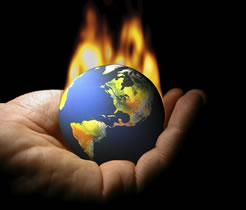HOTTEST APRIL ON RECORD SAYS NOAA
The combined global land and sea surface temperatures for April, and for January to April, were the warmest on record, according to measurements by
NCDC-NOAA.
Wednesday 19 May 2010
Friday 14 May 2010
ANOTHER CHEAP HYDROGEN CATALYST FROM MIT
Expanding on work published two years ago, MIT's Daniel Nocera and associates have found another formulation, based on inexpensive and widely available materials, that can efficiently catalyse the electrolysis of water. It could be the basis for new storage-systems that would allow buildings to be independent and self-sustaining in energy. They would use energy from intermittent sources like sunlight or wind to create hydrogen fuel, which could then be used in fuel cells or other devices to produce electricity or transportation fuels. The technology eliminates any need for expensive platinum, which has been an obstacle to the move to a sunlight/wind and split-water economy.
Full report at ScienceDaily.
Expanding on work published two years ago, MIT's Daniel Nocera and associates have found another formulation, based on inexpensive and widely available materials, that can efficiently catalyse the electrolysis of water. It could be the basis for new storage-systems that would allow buildings to be independent and self-sustaining in energy. They would use energy from intermittent sources like sunlight or wind to create hydrogen fuel, which could then be used in fuel cells or other devices to produce electricity or transportation fuels. The technology eliminates any need for expensive platinum, which has been an obstacle to the move to a sunlight/wind and split-water economy.
Full report at ScienceDaily.
Thursday 6 May 2010
OVERHEATED EARTH WILL KILL HUMANS
Reasonable worst-case scenarios for global warming could mean deadly temperatures for humans in coming centuries, according to research findings from Purdue University and the University of New South Wales, Australia.
Researchers have for the first time calculated the highest tolerable wet-bulb temperature and found that it could be exceeded for the first time in human history in future climate scenarios if greenhouse gas emissions continue at their current rate--ultimately reaching temperatures not seen on earth for 50 million years.
Wet-bulb temperature is equivalent to what is felt when wet skin is exposed to moving air. It includes temperature and atmospheric humidity and is measured by covering a standard thermometer bulb with a wetted cloth and fully ventilating it.
The researchers calculated that humans and most mammals, which have internal body temperatures near 37 degrees Celsius, will experience a potentially lethal level of heat stress at a wet-bulb temperature over 35 degrees that continues for six hours or more.
At worst whole countries would intermittently be subject to severe heat stress requiring large-scale adaptation efforts. Livestock would still be exposed. Outside work would be hazardous.
The Intergovernmental Panel on Climate Change estimates of business-as-usual warming by 2100 are 4 degrees Celsius, eventual warming of 14 degrees is feasible.
"We found that a warming of 7 degrees would cause some areas of the world to surpass the wet-bulb temperature limit, and a 12-degree warming would put half of the world's population in an uninhabitable environment. When it comes to evaluating the risk of carbon emissions, such worst-case scenarios need to be taken into account. It's the difference between a game of roulette and playing Russian roulette with a pistol. Sometimes the stakes are too high, even if there is only a small chance of losing."
A person produces 100 watts of heat, which has to be got rid of. If the wet-buld temperature is too high that becomes impossible.
"The wet-bulb limit is the point at which people would overheat even if they were naked in the shade, soaking wet and standing in front of a large fan. Although we are very unlikely to reach such temperatures this century, they could happen in the next."
Reasonable worst-case scenarios for global warming could mean deadly temperatures for humans in coming centuries, according to research findings from Purdue University and the University of New South Wales, Australia.
Researchers have for the first time calculated the highest tolerable wet-bulb temperature and found that it could be exceeded for the first time in human history in future climate scenarios if greenhouse gas emissions continue at their current rate--ultimately reaching temperatures not seen on earth for 50 million years.
Wet-bulb temperature is equivalent to what is felt when wet skin is exposed to moving air. It includes temperature and atmospheric humidity and is measured by covering a standard thermometer bulb with a wetted cloth and fully ventilating it.
The researchers calculated that humans and most mammals, which have internal body temperatures near 37 degrees Celsius, will experience a potentially lethal level of heat stress at a wet-bulb temperature over 35 degrees that continues for six hours or more.
At worst whole countries would intermittently be subject to severe heat stress requiring large-scale adaptation efforts. Livestock would still be exposed. Outside work would be hazardous.
The Intergovernmental Panel on Climate Change estimates of business-as-usual warming by 2100 are 4 degrees Celsius, eventual warming of 14 degrees is feasible.
"We found that a warming of 7 degrees would cause some areas of the world to surpass the wet-bulb temperature limit, and a 12-degree warming would put half of the world's population in an uninhabitable environment. When it comes to evaluating the risk of carbon emissions, such worst-case scenarios need to be taken into account. It's the difference between a game of roulette and playing Russian roulette with a pistol. Sometimes the stakes are too high, even if there is only a small chance of losing."
A person produces 100 watts of heat, which has to be got rid of. If the wet-buld temperature is too high that becomes impossible.
"The wet-bulb limit is the point at which people would overheat even if they were naked in the shade, soaking wet and standing in front of a large fan. Although we are very unlikely to reach such temperatures this century, they could happen in the next."
Monday 3 May 2010
CHEAP CATALYST MAKES HYDROGEN FROM WATER
A team of researchers with the U.S. Department of Energy's (DOE) Lawrence Berkeley National Laboratory (Berkeley Lab) and the University of California, Berkeley has discovered an inexpensive metal catalyst that can effectively generate hydrogen gas from water.
The new proton-reduction catalyst is based on a molybdenum-oxo metal complex that is about one seventieth the cost of platinum, the most widely used metal catalyst for splitting the water molecule. The new catalyst does not need organic additives, and can operate in neutral water, even if it is dirty. It can also operate in sea water, the most abundant source of hydrogen on earth and a natural electrolyte. It is therefore ideal for renewable energy and sustainable chemistry.
The research team found that the complex catalyses the generation of hydrogen from neutral buffered water or even sea water with a turnover frequency of 2.4 moles of hydrogen per mole of catalyst per second.
A team of researchers with the U.S. Department of Energy's (DOE) Lawrence Berkeley National Laboratory (Berkeley Lab) and the University of California, Berkeley has discovered an inexpensive metal catalyst that can effectively generate hydrogen gas from water.
The new proton-reduction catalyst is based on a molybdenum-oxo metal complex that is about one seventieth the cost of platinum, the most widely used metal catalyst for splitting the water molecule. The new catalyst does not need organic additives, and can operate in neutral water, even if it is dirty. It can also operate in sea water, the most abundant source of hydrogen on earth and a natural electrolyte. It is therefore ideal for renewable energy and sustainable chemistry.
The research team found that the complex catalyses the generation of hydrogen from neutral buffered water or even sea water with a turnover frequency of 2.4 moles of hydrogen per mole of catalyst per second.
Subscribe to:
Posts (Atom)

